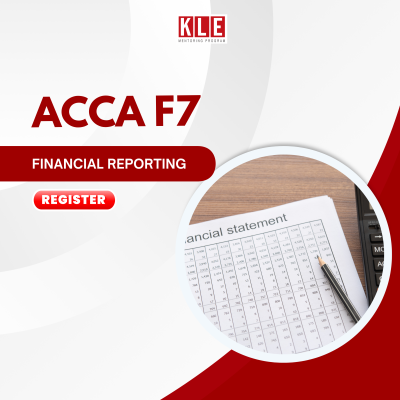Tại sao nên tham gia khóa học này?
Tại KLE Mentoring Program, các mentees sẽ được đào tạo về Thái độ – Kỹ năng – Kiến thức để trở thành kiểm toán viên phù hợp. Khóa học F7 ACCA hướng đến trang bị cho mentee về phần kiến thức chuyên môn – một yêu cầu căn bản đối với người hành nghề kiểm toán.
Sau khi hoàn thành khóa FR/F7 ACCA, mentees có thể ứng dụng kiến thức để thi môn Financial Reporting để tiếp tục chặng đường chinh phục chứng chỉ ACCA. Đối với các bạn sinh viên, kiến thức từ khóa học F7 là hành trang giúp các bạn thành công tại các cuộc thi chuyên môn Kế toán – Kiểm toán và xa hơn là tham gia các Kì tuyển dụng Thực tập sinh Kiểm toán tại các công ty kiểm toán lớn.
1. Nội dung học
* FR/F7 – Financial Reporting bao gồm 5 phần chính:
- The conceptual and regulatory framework: Khung khái niệm và khung pháp lý về kế toán
- Accounting for transactions in financial statements: Hạch toán các giao dịch trong báo cáo tài chính
- Preparing single entity financial statements: Lập báo cáo tài chính riêng lẻ
- Preparing consolidated financial statements: Lập báo cáo tài chính hợp nhất
- Analysis and interpretation of financial statements: Phân tích và giải thích các báo cáo tài chính
* So với môn học FA/F3, môn học FR/F7 đề cập đến những phần kiến thức phức tạp hơn như:
- Bất động sản đầu tư (IAS 40, Investment Property)
- Tài sản nông nghiệp (IAS 41, Agriculture)
- Thuê (IFRS 16, Lease)
- Chi phí vốn hóa (IAS 23, Borrowing cost)
- Công cụ tài chính (IFRS 9, Financial instruments)
- Thuế (IAS 12)
- Phân tích chỉ số trên báo cáo tài chính
2. Mục tiêu của môn học FR/F7
Mục tiêu chung
Trong môn học FR/F7 – Financial Reporting, người học sẽ được:
Mục tiêu với nghề kiểm toán
Đối tượng (subject matter) của công việc kiểm toán là Báo cáo tài chính, vì vậy kiểm toán viên cần được trang bị đầy đủ kiến thức về Kế toán tài chính. Môn FR/F7 – Financial Reporting sẽ cung cấp hiểu biết về các chuẩn mực báo cáo tài chính và cách các chuẩn mực được áp dụng trong quá trình lập báo cáo tài chính. Đây là cơ sở để kiểm toán viên đưa ra ý kiến về sự trung thực và hợp lý của các thông tin trên báo cáo tài chính của đơn vị.
3. Hình thức tham gia thi FR/F7
Bài thi FR/F7 kéo dài 3 tiếng và 10 phút cho thí sinh đọc đề. Tất cả các câu hỏi là bắt buộc. Bài kiểm tra sẽ bao gồm cả yếu tố tính toán và giải thích.
Bài thi FR/F7gồm 3 phần:
Các câu hỏi của phần 1 và phần 2 có thể bao gồm tất cả các kiến thức của Kế toán tài chính ( Bao gồm cả FA/F3 và FR/F7). Phần 3 sẽ kiểm tra việc giải thích và lập báo cáo tài chính cho một đơn vị.
5 Bài học - 0 phút
3 Bài học - 23 phút
6 Bài học - 48 phút
6 Bài học - 24 phút
13 Bài học - 1 giờ 44 phút
9 Bài học - 1 giờ 16 phút
12 Bài học - 2 giờ 59 phút
18 Bài học - 4 giờ 1 phút
11 Bài học - 2 giờ 25 phút
6 Bài học - 1 giờ 19 phút
